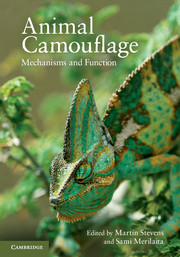Book contents
- Frontmatter
- Contents
- Contributors
- 1 Animal camouflage
- 2 Crypsis through background matching
- 3 The concealment of body parts through coincident disruptive coloration
- 4 The history, theory and evidence for a cryptic function of countershading
- 5 Camouflage-breaking mathematical operators and countershading
- 6 Nature's artistry
- 7 Camouflage behaviour and body orientation on backgrounds containing directional patterns
- 8 Camouflage and visual perception
- 9 Rapid adaptive camouflage in cephalopods
- 10 What can camouflage tell us about non-human visual perception? A case study of multiple cue use in cuttlefish (Sepia spp.)
- 11 Camouflage in marine fish
- 12 Camouflage in decorator crabs
- 13 Camouflage in colour-changing animals
- 14 The multiple disguises of spiders
- 15 Effects of animal camouflage on the evolution of live backgrounds
- 16 The functions of black-and-white coloration in mammals
- 17 Evidence for camouflage involving senses other than vision
- Index
- Plate section
- References
12 - Camouflage in decorator crabs
Integrating ecological, behavioural and evolutionary approaches
Published online by Cambridge University Press: 05 June 2012
- Frontmatter
- Contents
- Contributors
- 1 Animal camouflage
- 2 Crypsis through background matching
- 3 The concealment of body parts through coincident disruptive coloration
- 4 The history, theory and evidence for a cryptic function of countershading
- 5 Camouflage-breaking mathematical operators and countershading
- 6 Nature's artistry
- 7 Camouflage behaviour and body orientation on backgrounds containing directional patterns
- 8 Camouflage and visual perception
- 9 Rapid adaptive camouflage in cephalopods
- 10 What can camouflage tell us about non-human visual perception? A case study of multiple cue use in cuttlefish (Sepia spp.)
- 11 Camouflage in marine fish
- 12 Camouflage in decorator crabs
- 13 Camouflage in colour-changing animals
- 14 The multiple disguises of spiders
- 15 Effects of animal camouflage on the evolution of live backgrounds
- 16 The functions of black-and-white coloration in mammals
- 17 Evidence for camouflage involving senses other than vision
- Index
- Plate section
- References
Summary
Camouflage is one of the most common anti-predator strategies in the animal kingdom, and many examples of camouflage have become classic case studies of adaptation and natural selection (Cott 1940; Kettlewell 1955; Stevens & Merilaita 2009). Although most examples of animal camouflage involve body coloration or patterning, decorator crabs in the brachyuran superfamily Majoidea (majoids) are a large and diverse group of crabs best known for a distinctive form of ‘decoration’ camouflage, in which they attach materials from the environment to specialised hooked setae on their body. This unique form of camouflage is dependent both on crab morphology and behaviour, and makes decorator crabs an ideal group in which to study the adaptive consequences and mechanistic bases of camouflage. Decorator crabs are also fairly unusual among camouflaged animals in that the adaptive anti-predatory consequences of decoration camouflage have in many cases been directly tested in the field (Stachowicz & Hay 1999b; Thanh et al. 2003; Hultgren & Stachowicz 2008a). Yet despite its clear adaptive value, decoration camouflage varies widely across the majoids – both within and between species. Many majoids exhibit intra- and interspecific decreases in decoration with size (Dudgeon 1980; Wicksten 1993; Stachowicz & Hay 1999b; Berke & Woodin 2008; Hultgren & Stachowicz 2009). Along with experimental work documenting energetic costs of carrying decoration (Berke & Woodin 2008), and trade-offs with other forms of defence (Hultgren & Stachowicz 2008a), these data suggest that cost–benefit trade-offs may drive the evolution of decoration in these crabs (Hultgren & Stachowicz 2009). These results more broadly imply that the value of camouflage as a concealment strategy is strongly influenced by constraints such as body size, providing predictions to be tested in other groups of organisms.
- Type
- Chapter
- Information
- Animal CamouflageMechanisms and Function, pp. 212 - 236Publisher: Cambridge University PressPrint publication year: 2011
References
- 22
- Cited by



